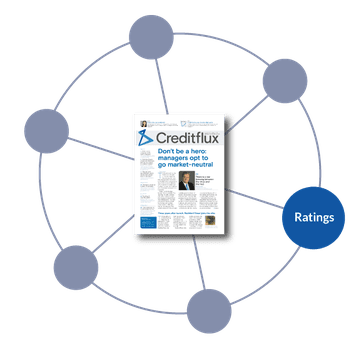

November 2020 | Issue 229
Analysis
CLOs
Elements work against CLO managers in Q3

Charlie Dinning
Data journalist

Tanvi Gupta
Head of data journalism
CLO equity distributions fell in Q3 largely due to factors, such as Libor mismatches, that CLO managers can’t control. But these headwinds could turn in favour of managers in the near future
A perfect storm of Libor mismatch in the US, issuers switching payment frequencies and interest smoothing in portfolios led to lower equity payments across the board in the third quarter of 2020.
Nevertheless, there were profitable opportunities for CLO managers. Justin Driscoll, portfolio manager at Gallatin Loan Management, says: “Dislocations tend to provide opportunities to de-risk without a lot of pain.” On its two US CLOs that went effective in 2018 or 2019, Gallatin averaged an annualised payment of 16.83% against the market average of 9.81%.
The manager lost an average of 1.24% of par on Gallatin VIII and IX to the lowest recorded over-collateralisation (OC) test result for both, but Driscoll points out that, in July, CLO managers were still trading their way through dislocations — so the position of a portfolio before coronavirus-induced volatility was key. “What you did in the previous 6-12 months is as important as what you do during the dislocation,” he says.
PGIM had the second highest average annualised payment in the third quarter for the European CLO market. Across its six deals that went effective in 2018-19, the global fixed income giant averaged 14.29% annualised to equity. Only GoldenTree Asset Management topped PGIM. It had a 14.55% average distribution. The European CLO market average was 9.54%.
2018/19 US CLOs in Q3: annualised payments to equity vs change in par
* diverted payments ** includes triple C flex deals

* diverted payments ** includes triple C flex deal
Prefer to defer CLOs storm back
PGIM opted to defer some of its equity payments in the second quarter on its European CLOs. This meant the manager averaged a payment of just 1.49% annualised to equity holders, as it chose to divert “funds to the collateral enhancement account as a reserve against potential workout situations”, according to the manager’s April trustee reports.
Also in Europe, Anchorage Capital, Barings and Intermediate Capital Group opted, in the third quarter, for the same tactic to shore up debt tranches and increase subordination. This move is viewed favourably by CLO debt investors, which means it can potentially help the manager access reduced funding costs in future deals.
9.8%
Q3 averaged annualised payment in US CLOs
Fortress Investment Group also chose to divert a portion of equity payments, in its case for the second quarter payment dates on Fortress V. As for PGIM in Europe, this decision looks to have paid off. Fortress paid just 1.57% annualised on Fortress V in April but rebounded to pay 15.45% in July. It bettered even that with an annualised 18.1% on Fortress VII to average 16.77% across both deals, a figure topped only by Gallatin.
Despite PGIM and Fortress placing second in the average payment tables, market sources have indicated that there is only a weak correlation between deferring payments in the previous quarter and a good payment this time around. This is because assets bought with diverted funds do not necessarily pay interest in the interim.
Some managers did not intentionally divert payments into their deals but were forced to do so due to failed OC tests. Others traded purposely to cure OC tests or, as sources suggest, aimed instead at keeping a good credit portfolio.
2018/19 European CLOs in Q3: annualised payments to equity vs change in par

* diverted payments

* diverted payments
9.5%
Q3 averaged annualised payment in European CLOs
Libor works against CLOs in Q3
When Libor is not in CLO managers’ favour, it does not make sense for them to focus on a specific payment date. For US CLO payments made in the third quarter, the mismatch between one and three-month Libor, in April, when rates were locked in, immediately put CLO managers on the back foot.
Three-month Libor dropped to 0.74% in March after the Federal Reserve intervened in capital markets to stimulate the economy. But by early April the base rate had rebounded to 1.44% as banks were willing to pay a higher rate for funds by the end of the quarter.
CLOs that made equity payments in early July had their liabilities benchmarked to the peak early April rates before Libor crashed once again to lows of 0.24%. As a result, loans in CLO portfolios that paid interest monthly referenced a much lower base rate than the CLOs’ liabilities. The effect of this can be seen across the market, with US CLOs that went effective in 2018 and 2019 averaging an annualised equity payment of 9.81% in the third quarter of 2020, compared to 12.78% in the second quarter.
According to Nomura research, the median equity cash-on-cash distribution across the entire US CLO market dropped by 10-70 basis points in July due to the lagging effect of a decline in rates and the whipsaw in the three and one-month Libor rates over this collection period.
Additionally, loan issuers in both markets switched payment frequencies to preserve liquidity. In the US, issuers changed from monthly to quarterly payments and in Europe from quarterly to biannually. Frequency switching did not have an impact on CLO interest accrual, say market sources, but it did push out payments that would have been due on third quarter dates.

“Dislocations tend to provide opportunities to de-risk without a lot of pain”
Justin Driscoll, Portfolio Manager | Gallatin
Taking the rough with the smooth
As a result of European loan issuers switching to semi-annual payments, European CLO managers had to deal with interest smoothing in their portfolios. The act of putting money into smoothing accounts means that CLO managers are hit twice, according to one CLO manager.
The first hit comes from assets not paying interest, as the payment date has been moved later; the second comes from “aggressive smoothing” as 50% of the money paid by the issuer on the CLO’s assets is put aside due to it being six-monthly money. This means CLO managers are playing catch up and results will be skewed, even if in the long run payments even out.
European CLO portfolios have a large overlap in underlying loans and the effect of corporate debt issuers switching to semi-annual payments was widespread across the market, with one manager highlighting that 57% of the portfolio he runs is now semi-annual. “As a result, we lost roughly 3% in the summer,” says the portfolio manager.
The diversion to smoothing accounts is carried out automatically and can sometimes be more than the equity payment made in a period. This happened on MeDirect’s sole European CLO, Grand Harbour 2019-1. The deal paid €481,000 to equity holders on its July payment date, but put €489,000 into its smoothing account.
These factors meant that average European CLO annualised payments in the third quarter were materially lower than those in April. The market average in Q3 was 9.54%; in the second quarter, European CLOs that went effective in 2018 and 2019 averaged a distribution of 11.05% annualised.
But this fall is reflective of the long-term view CLO managers take. The switching of payment frequencies by issuers had a negative impact on third quarter equity payments but will have a positive effect on fourth quarter payments. European CLO managers also told Creditflux that some corporate debt issuers are switching back to quarterly payments, after switching to semi-annual in the summer.
October saw fewer OC test failures than July. Assets that CLO managers bought at a discount at the peak of covid-19-induced volatility have rebounded and increased the par of deals, enabling more CLOs to make payments.
The Libor rates that CLO liabilities referenced dropped by around 1% from their April peak, to closer to 0.25% on average, leading to an increase in the cash available to pay equity investors.
On top of this, CLO managers had the added benefit of trading with the Libor floor on their portfolios kicking in, which, according to Driscoll, means “you can trade a little running coupon as you’re getting an uplift in your overall yield”. This factor led to around a 30-35bp annualised pickup in net arbitrage.
Methodology
- Data includes CLOs that went effective in 2018 and 2019, that have made at least one payment.
- Bond-flex, middle market and static CLOs were excluded.
- Annualised return (%) is calculated assuming equity issued at par.
- Manager change in WAS: average change in WAS over three months from first reports published after 15 March.
- Manager change in OC: average change in junior-most OC test results over three months from first reports published after 15 March.
- All data from CLO-i and Moody’s Analytics
Share this article:
Global credit funds & CLO's
November 2020
| Issue 229Published in London & New York.
Copyright Creditflux. All rights reserved. Check our Privacy Policy and our Terms of Use.


























